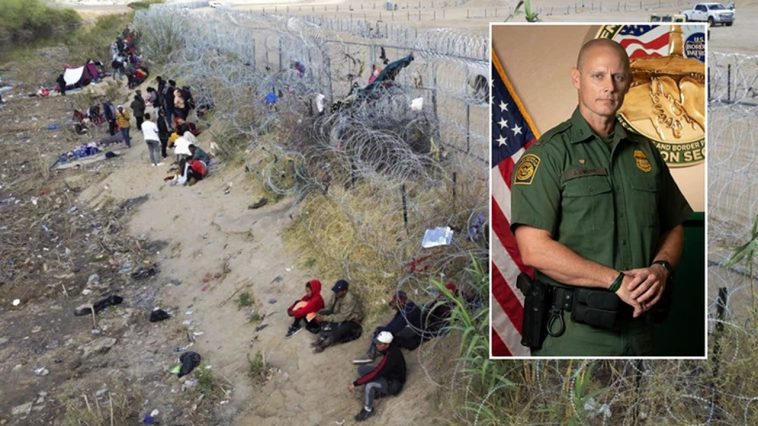Chief Jason Owens, Chief of the U.S. Border Patrol, has implicated current governmental policy in escalating security issues along the U.S.-Mexican border, highlighting concerns over illicit entry. He opines that these lax border control measures have inadvertently given power to Mexican cartels, essentially dictating the dynamics of illegal movement. The authorities, he insists, often find themselves in a reactive position, striving to eliminate the cartels’ avenues of illicit operations.
While the task of Border Patrol authorities is to thwart dangerous situations for both officers and immigrants, the magnitude of the border, spanning approximately 1,900 miles, poses a daunting challenge. There are around 20,000 border patrol agents, a number that may seem considerable. However, once factoring in the relentless 24/7 nature of the job and the vast expanse of territory to cover, it quickly becomes apparent that resources may be stretched thin.
It’s a troubling strategy by the cartels who manipulate the humanity of the situation. By pushing groups of migrants across the border, they fully expect the Border Patrol to divert resources to act from a humanitarian perspective, ensuring safety. This effectively leaves the cohort unduly stretched and vulnerable to other illicit activities coordinated by the cartel.
Owens expresses a sense of foreboding about the inflow of unknown individuals into the nation, pointing out that their unidentified status and unfathomable intentions pose a considerable concern for those tasked with border security. On the brink of a million entries in just the current fiscal year, it is not just the absolute figure that is worrisome. Approximately 140,000 are ‘getaways,’ or individuals who have successfully evaded the authorities.
The magnitude of these ‘getaways’ is not a trivial matter; their unknown identity, origin or intents have the capacity to pose a genuine risk to national security. Owens underscores that ensuring border security is a vital part of maintaining overall national security. Ignorance of who is entering our nation, and for what purposes, sheeds light upon a critical vulnerability at our borders.
In the light of the recent surge in unauthorized immigrations, public sentiment has been echoing similar concerns. A wide array of polls indicates that illegal immigration has emerged as a paramount issue this election year, captivating the interest of most Americans. The rising tide of illicit entries into the country does nothing to alleviate these apprehensions.
The Department of Homeland Security provided a snapshot of this escalating scenario in February, accounting for over 256,000 encounters with unauthorized migrants. The recorded encounters included both events at the southern border and those presenting themselves at crossings seeking entry. This tumultuous scenario has been duly recorded by The Washington Times, shedding light on the extent of the predicament.
A significant portion of these interactions, approximately 190,000 in number, were predominantly situated at the southern border, with about 141,000 resulting in Border Patrol custodies. To add to the complexity, further individuals on the government’s terrorism watchlist were among those apprehended, intensifying concerns for national security.
The situation is further complicated by the high volume of unauthorized migrants arriving at legal crossings, seeking admission into the country. A significant subset, over 42,000, sought access under a controversial ‘parole’ scheme initiated by Homeland Security Secretary Alejandro Mayorkas in an attempt to ease the pressure on Border Patrol agents.
This program, referred to as the CBPOne App, offers migrants the opportunity to schedule their border arrival to seek entry. A similar arrangement is provided under a separate parole initiative, which has been set up to preemptively schedule the arrivals of up to 30,000 migrants from nations such as Cuba, Haiti, Nicaragua, and Venezuela at domestic airports.
Politicians across the spectrum, especially Republicans, have been critical of current Federal immigration policies. The criticism reached a crescendo on President Biden’s first day in office when several immigration rules that had previously been in place were reversed, causing concern among many observers.
Historically established and effective policies were overturned, much to the chagrin of conservative parties. Some of the decisions have been especially contentious, with critics alleging successive policies encouraging rather than discouraging unlawful entry.
The head of the House Homeland Security Committee, Representative Mark Green from Tennessee, exemplified this viewpoint. He decried Secretary Mayorkas’s admission of a border crisis as too little, too late. Green also took aim at the mass catch-and-release and parole programs in place, suggesting that they were perpetuating, not alleviating, the issues faced.
The immigration policy landscape is evidently marked by stark disagreements and gathering trepidation. The daunting figures of encounters with spurious individuals, coupled with those who evade authority and successfully penetrate U.S. borders, illustrate a fraught picture.
Clearly, these figures indicate the necessity for a review of current border policies. For those tasked with the onerous responsibility of guarding our nation’s frontiers, the need for robust and effective measures has never been more pressing.


